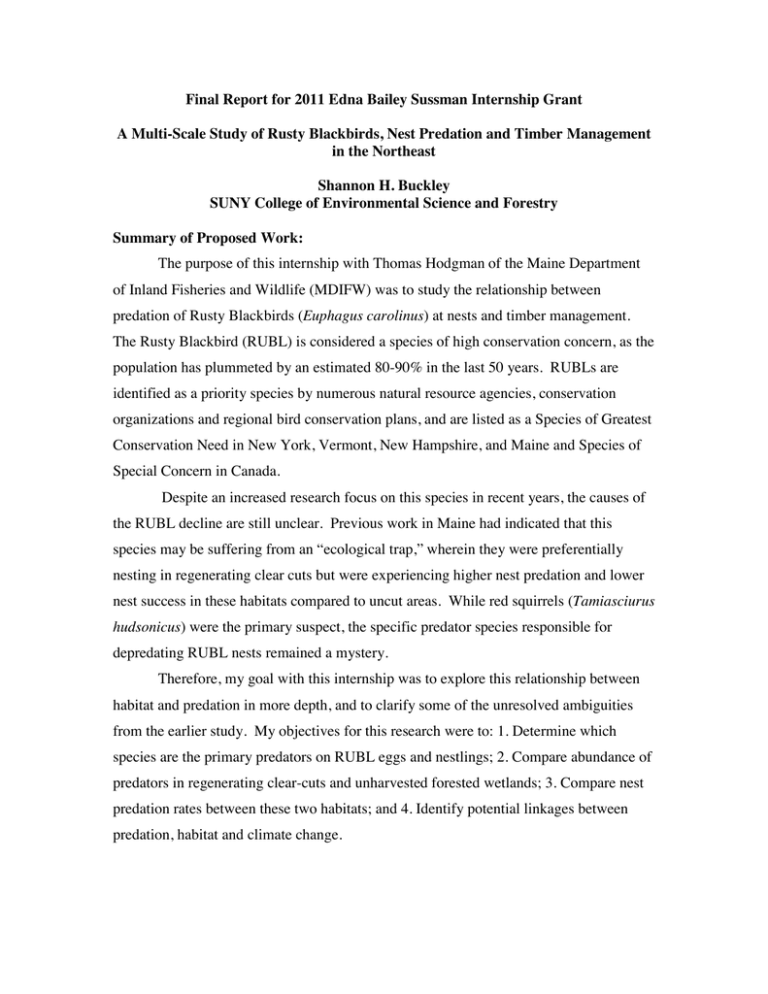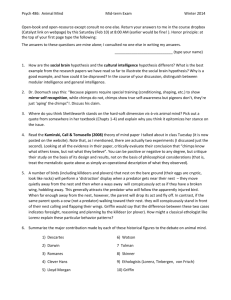Final Report for 2011 Edna Bailey Sussman Internship Grant
advertisement

Final Report for 2011 Edna Bailey Sussman Internship Grant A Multi-Scale Study of Rusty Blackbirds, Nest Predation and Timber Management in the Northeast Shannon H. Buckley SUNY College of Environmental Science and Forestry Summary of Proposed Work: The purpose of this internship with Thomas Hodgman of the Maine Department of Inland Fisheries and Wildlife (MDIFW) was to study the relationship between predation of Rusty Blackbirds (Euphagus carolinus) at nests and timber management. The Rusty Blackbird (RUBL) is considered a species of high conservation concern, as the population has plummeted by an estimated 80-90% in the last 50 years. RUBLs are identified as a priority species by numerous natural resource agencies, conservation organizations and regional bird conservation plans, and are listed as a Species of Greatest Conservation Need in New York, Vermont, New Hampshire, and Maine and Species of Special Concern in Canada. Despite an increased research focus on this species in recent years, the causes of the RUBL decline are still unclear. Previous work in Maine had indicated that this species may be suffering from an “ecological trap,” wherein they were preferentially nesting in regenerating clear cuts but were experiencing higher nest predation and lower nest success in these habitats compared to uncut areas. While red squirrels (Tamiasciurus hudsonicus) were the primary suspect, the specific predator species responsible for depredating RUBL nests remained a mystery. Therefore, my goal with this internship was to explore this relationship between habitat and predation in more depth, and to clarify some of the unresolved ambiguities from the earlier study. My objectives for this research were to: 1. Determine which species are the primary predators on RUBL eggs and nestlings; 2. Compare abundance of predators in regenerating clear-cuts and unharvested forested wetlands; 3. Compare nest predation rates between these two habitats; and 4. Identify potential linkages between predation, habitat and climate change. Work Completed: During May and June of 2011, I conducted over 300 broadcast surveys for Rusty Blackbirds using an adult call on a playback mechanism. I located and monitored 13 Rusty Blackbird nests and found an additional 18 wetlands occupied by Rusty Blackbirds after the young had already fledged. Ten of the thirteen nests were monitored with a camera for at least part of the nesting period and I made repeat visits to monitor nestling survival and development. After the nesting cycle was completed in July and August, I measured vegetation and habitat characteristics within a 5-m radius around each nest as well as in a control plot randomly placed 50m from the nest. I also measured vegetation on a fourteenth nest found immediately after the young had fledged. Finally, because red squirrels were hypothesized to be the primary nest predator, I conducted broadcast surveys for squirrels at nest sites as well in select mature stands to serve as an index to changes in squirrel abundance. Throughout the field season, I met with MDIFW and timber company personnel to discuss the applications of this research to local landscape management. Preliminary Results: There were typically four or five eggs per nest, and hatching success was usually 100%. There were a couple of instances, however, where I noted an unhatched egg left behind after the brood had fledged. Three nests of known fate were depredated (Figure 1). Two predation events were documented with cameras (a hawk, Accipiter sp., and a white-tailed deer, Odocoileus virginianus) and one was by an unknown predator. It should be noted that the nest depredated by the deer was an anomaly in terms of nest placement, as it was constructed in a snag less than a meter off the ground and was completely exposed. Therefore, while anecdotally interesting, it seems unlikely that deer are significant predators of RUBL nests at the population level. At the nest site scale, mean nest placement was at 1.75 meters high (SE=0.127). Nest trees were on average 3.49 meters tall (SE=0.27). The majority of nests were in red/black spruce (Picea rubens/mariana) or balsam fir (Abies balsamea), with only two in snags or cedar (Thuja occidentalis) (Figure 2). Based on one summer of data, RUBLs seem to have relatively high nest success, and nest predation appears to be rare even in regenerating clear cuts. There were no documented cases of red squirrels depredating a nest, which was the suspected primary nest predator. With a current sample size of two, however, I cannot yet make any inferences regarding patterns of nest predation and timber management. Thus, I will monitor nests again in spring 2012, which will allow me to gather more data. There were very few squirrels detected during surveys this year, both around nest sites and in mature forests. We detected squirrels in only one out of 12 mature forests, and two out of 14 nest locations. Given the abundant cone crop on this year’s trees, however, squirrels and other small mammalian nest predators are expected to increase in 2012. Therefore, the combined data from these two years could potentially provide critical and novel insight into the dynamics of cyclical predator populations and the ecological trap phenomenon. Climate change may also have an effect on this process due to the fact that cone production is strongly influenced by annual temperature, and warmer temperatures could mean larger and more frequent cone crops. Determining if predation dynamics differ between logging-impacted areas and undisturbed habitats, and how environmental factors such as climate change might alter such dynamics should provide insight into how to best mitigate these effects. Figure 1. Number of successful, failed and unknown nests (n=14). Figure 2. Proportion of nests in different tree species (n=14). Future Work: I am currently in the early stages of analyzing the data from this summer’s fieldwork. I will conduct statistical analyses on vegetation and habitat variables, as well a geospatial habitat analysis using GIS. This should provide more detailed insight into landscape-level nesting habitat selection and the role of timber management. Finally, I will continue to collect more data during a second field season in 2012. The Edna Bailey Sussman Foundation has been and will continue to be acknowledged in all presentations and reports resulting from this study. Photos (all credited to Shannon Buckley of SUNY ESF): Checking a camera Wading through a wetland to look for nests Camera Set-up on Pole RUBL nestlings in the nest Measuring nest height during vegetation plots RUBL female on the nest QuickTime™ and a decompressor are needed to see this picture. RUBL male Example photo from one of the nest cameras







